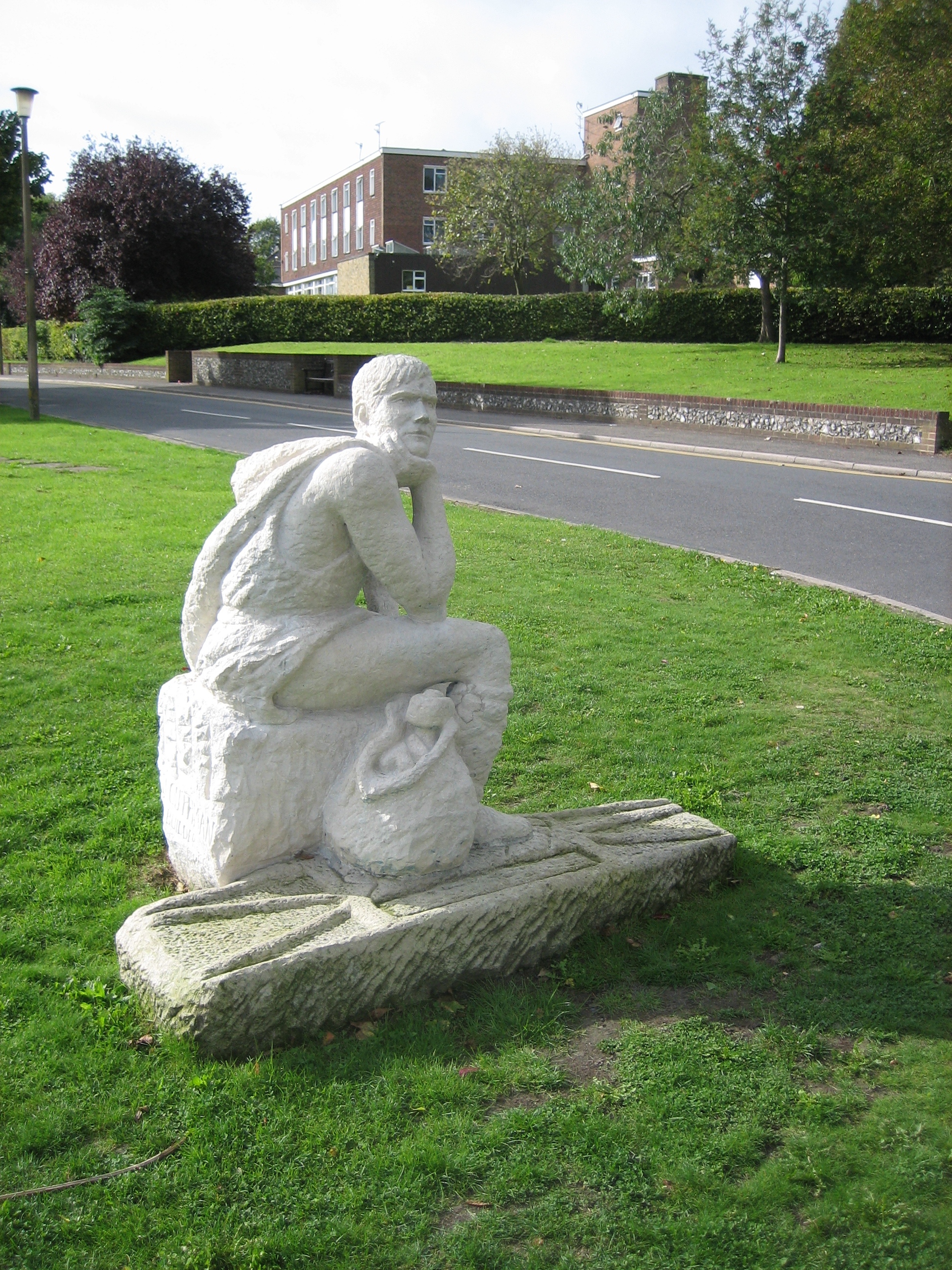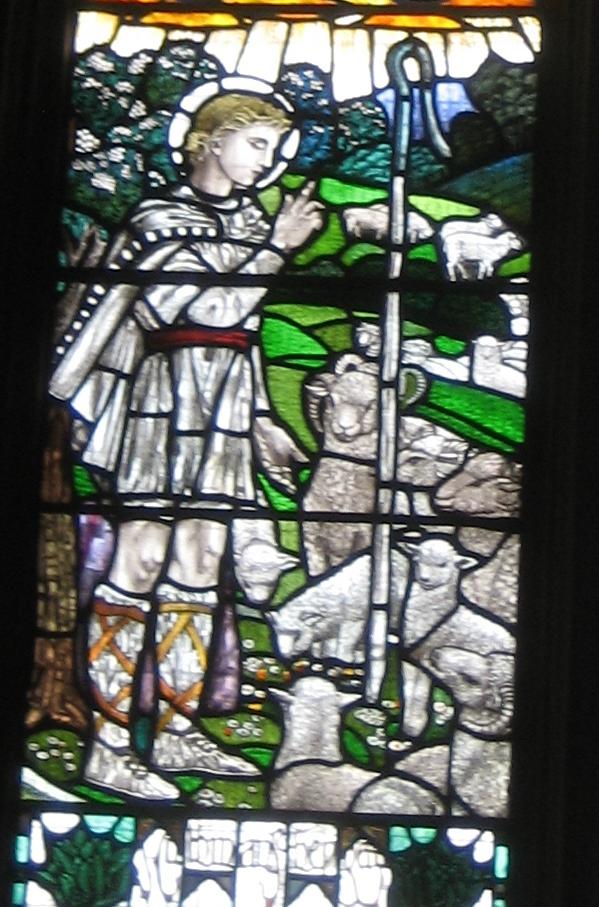Saint Cuthman
vénéré dans le Sussex (date ?)
(+v. 889? - VIIIe ou IXe siècle suivant les sources)
Originaire d'une famille chrétienne anglo-saxonne, dans le Sussex, il pourvut à la subsistance familiale après la mort de son père, parfois même en mendiant, ce qu'il faisait avec beaucoup d'humilité et de douceur. Puis il bâtit une petite cabane pour lui et sa mère fort âgée afin de suivre ce commandement: 'Tu honoreras ton père et ta mère longuement'. Il mourut pauvre berger. Les habitants du lieu le vénéraient comme un saint.
Ses reliques sont actuellement à Fécamp.
A lire (en anglais): St Cuthman of Steyning - site du diocèse d'Arundel et Brighton.
Also known as
Cuthmann
Profile
Poor but
pious youth from the south of England.
Cared for his invalid mother following
his father‘s death. Shepherd,
spending his time with the flock in prayer. Built a
church near his property near Steyning, Sussex, England. Miracle worker
in life and afterward.
Additional Information
Book of
Saints, by the Monks of
Ramsgate
Lives
of the Saints, by Father Alban
Butler
Saints
of the Day, by Katherine Rabenstein
books
Our Sunday Visitor’s Encyclopedia of Saints
other sites in english
video
MLA Citation
“Saint Cuthman“. CatholicSaints.Info. 17 May
2020. Web. 3 March 2021. <https://catholicsaints.info/saint-cuthman/>
SOURCE : https://catholicsaints.info/saint-cuthman/
Stained-glass window depicting St Cuthman of Steyning, (Cuthmann Chapel, Steyning, 2006)
St. Cuthman, in England, Confessor
THE SPIRITUAL riches of divine grace were the happy portion of this saint, who seemed from his cradle formed to perfect virtue. His name demonstrates him to have been an English-Saxon, not of British extraction, either from Wales or Cornwall, as Bollandus conjectured. He was born in the southern parts of England, and, from the example of his pious parents, inherited the most perfect spirit of Christian piety. From his infancy he never once transgressed their orders, in the least article, and when sent by his father to keep his sheep, he never failed coming home exactly at the time appointed. This employment afforded him an opportunity of consecrating his affections to God, by the exercises of holy prayer, which only necessary occasions seemed to interrupt, and which he may be said to have always continued in spirit, according to that of the spouse in the Canticles, I “sleep, but my heart watcheth.” By the constant union of his soul with God, and application to the functions and exercises of the angels, the affections of his soul were rendered daily more and more pure, and his sentiments and whole conduct more heavenly and angelical. What gave his prayer this wonderful force in correcting and transforming his affections, was the perfect spirit of simplicity, disengagement from creatures, self-denial, meekness, humility, obedience, and piety, in which it was founded. We find so little change in our souls by our devotions, because we neglect the practice of self-denial and mortification, live wedded to the world, and slaves to our senses and to self-love, which is an insuperable obstacle to this principal effect of holy prayer. Cuthman, after the death of his father, employed his whole fortune and all that he gained by the labour of his hands, in supporting his decrepit mother: and afterwards was not ashamed to beg for her subsistence. To furnish her necessaries by the sweat of his brow, and by the charitable succours of others, he removed to several places; nor is it to be expressed what hardships and austerities he voluntarily and cheerfully suffered, which he embraced as part of his penance, increasing their severity in order more perfectly to die to himself and to his senses, and sanctifying them by the most perfect dispositions in which he bore them.
Finding, at a place called Steninges, a situation according to his desire, he built there a little cottage to be a shelter from the injuries of the air, in which, with his mother, he might devote himself to the divine service, without distraction. His hut was no sooner finished but he measured out the ground near it for the foundation of a church, which he dug with his own hands. The inhabitants, animated by his piety and zeal, contributed liberally to assist him in completing this work. The holy man worked himself all day, conversing at the same time in his heart with God, and employed a considerable part of the night in prayer. Here he said in his heart: “Whither shall I go from thy spirit, O Lord! this is the place of my rest for ever and ever, in which I will every day render to thee my vows.” His name was rendered famous by many miracles of which God was pleased to make him the instrument, both living and after his death. He flourished about the eighth century, and his relics were honoured at Steninges. This place Saint Edward the Confessor bestowed on the great abbey of Fecam in Normandy, which was enriched with a portion of his relics. This donation of Steninges, together with Rye, Berimunster, and other neighbouring places made to the abbey of Fecam, was confirmed to the same by William the Conqueror, and the two first Henries, whose charters are still kept among the archives of that house, and were shown me there. This parish and that of Rye, were of the exemption of Fecam, that is, were not subject to the jurisdiction of the diocesan, but to this abbey, as twenty-four parishes in Normandy are to this day: For in the enumeration of the parishes which belong to this exemption in the bulls of several popes, in which it is confirmed, Steninges and Rye are always mentioned with this additional clause, that those places are situated in England. 1 St. Cuthman was titular patron of Steninges or Estaninges, and is honoured to this day, on the 8th of February, in the great abbeys of Fecam, Jumieges, and others in Normandy: and his name occurs in the old Missal, used by the English Saxons, before the Norman conquest, kept in the monastery of Jumieges, in which a proper mass is assigned for his feast on the 8th of February. In the account of the principal shrines of relics of saints, honoured anciently in England, published by the most learned Dr. Hickes, mention is made of St. Cuthman’s, as follows: “At Steninge, on the river Bramber, among the South-Saxons, rest St. Cuthman.” See Narratio de Sanctis qui in Anglia quiescunt, published by Hickes, in his Thesaurus Linguarum veterum Septentr, t. 1. in Dissert. Epistol. p. 121. See also two lives of St. Cuthman, in Bollandus, t. 2. Feb. p. 197. and the more accurate lessons for his festival in the Breviary of Fecam. He is honoured in most of the Benedictin abbeys in Normandy.
Note 1. Bollandus had not seen these charters and bulls, or he could not have supposed Steninges to be situated in Normandy, and St. Cuthman to have died in that province. Dom Le Noir, a learned Benedictin monk of the congregation of St. Maur, and library-keeper at Fecam, who is employed in compiling a history of Normandy, gives me the following information by a letter from Fecam: “On tient ici à Fécam par une espéce de tradition que Hastings, port d’Angleterre, sur la Manche, dans le comté de Sussex, et dans le voisinage de Rye, est le Staninges de l’Abbaye de Fécam. Si le nom est un peu différent aujourd hui, on voit des noms des lieux qui ont souffert des plus grandes altérations.” This pretended tradition is an evident mistake. Hastings was a famous sea-port under the same name, in the ninth century, and Stening is, at this day, a borough in Sussex, situated under the ruins of Bramber Castle, not far from the river, which was formerly navigable so high, though at present even Shoreham at its mouth has no harbour, the sea having made frequent great changes on this coast, especially in the twelfth century. [back]
Rev. Alban Butler (1711–73). Volume II: February. The Lives of the Saints. 1866.
SOURCE : http://www.bartleby.com/210/2/085.html
On this day: St. Cuthman of Steyning
When his father died, around the turn of the eighth century, Cuthman was reduced to begging. He decided to travel east, toward the rising sun. Because his mother was unable to walk, Cuthman built a cart in which to wheel her.
At one point on their journey, the rope by which Cuthman pulled the cart broke, and he devised a new one from withies. Mowers observed this and laughed at the makeshift rope. While they mocked him, it began to rain, and the downpour destroyed their crop. After that, it rained on that meadow every year during the hay harvest.
Cuthman realized he and his mother were under divine protection. He promised to continue wheeling the old lady along until the rope of withies broke. At that place, he would build a church.
The brittle rope broke at Steyning. Cuthman built a hut in which he and his mother could live, and then he set to work building a church. Construction went well with the aid of local people and with a pair of oxen given to Cuthman. But then two men stole the oxen and fenced them in their mother's yard. Cuthman yoked the two men to the cart and made them pull it. When their mother cursed the day of Cuthman's birth, a wind arose that blew her up into the air and then dropped her to the earth where she was swallowed up.
Another time, the main roof beam of the church fell, making it impossible for Cuthman and his workman to complete construction. While they were trying to decide how to solve the problem, a stranger appeared who told them exactly what to do. They did as he said, and the church was finished. Cuthman asked, "Who are you?" The stranger replied, "I am the one in whose name thou buildest this temple."
Or, as the playwright Christopher Fry had him say in The Boy With a Cart, "I was a carpenter."
It was in a 1950 production of The Boy With a Cart, Cuthman, Saint of Sussex: A Play, directed by John Gielgud, that Richard Burton played his first leading role.
"'It was a play with no set,' Gielgud recalled. 'Everything was constructed out of Burton's great talent for miming. He mimed building a cathedral, and it was spell-binding to watch him.'"
--from Richard Burton: Prince of Players, by Michael Munn, Skyhorse Publishing, 2008.
Clickhttp://www.youtube.com/watch?v=H8mRCQvSkEo>here for a YouTube of Richard Burton reciting a few lines from the play, at 2:29.
The various symbols in the legends surrounding St. Cuthman make it clear that this was a time of transition from the old Saxon religion to the new Roman religion: Steyning (stone people); wheel (the turning seasons); forces of nature that take vengeance on those who cross Cuthman and Mother; the witch; the oxen (favorite sacrifices of Saxons to their gods); and the building of a church on a place of stones (where humans and oxen had been sacrificed).We can picture Cuthman living in Steyning, continuing his work as shepherd and builder, but above all (as his biographer attests) as a man of prayer. He had accomplished his great work for God; the church he built would stand as his memorial.
San Cutmano Venerato a Fetcamp
IX sec.
San Cutmano (Cuthmann o Cutmanus), venerato a Fétcamp, visse nel secolo IX.
Non sappiamo se fosse irlandese o inglese di nascita; morì a Steninges in Normandia sul finire del IX secolo.
C’è una leggenda che ci racconta come San Cutmano e sua madre vivevano in una misera capanna proprio a Steninges, nella più completa povertà.
Le sue reliquie erano venerate a Steningers; solo in epoca successiva furono trasferite nell’abbazia benedettina della Santissima Trinità di Fécamp, dove oggi è anche custodita la preziosa reliquia del Santo Sangue.
La festa per San Cutmano, nei diversi martirologi, ricorre nel giorno 8 febbraio.
Autore: Mauro Bonato



.jpg)